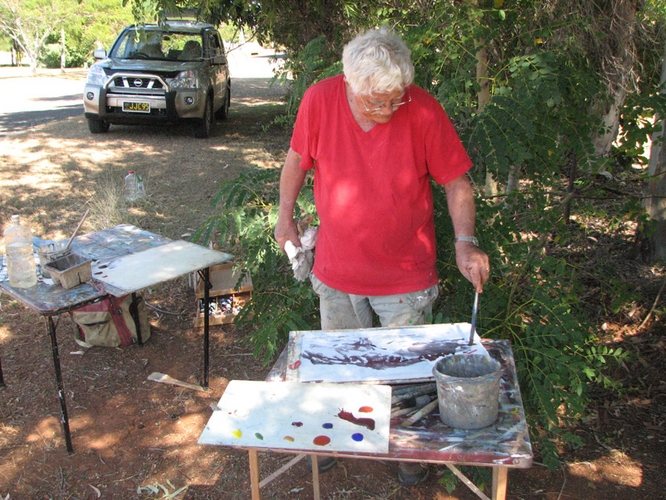
Everyone now knows that the old typecast world of fast drying acrylics is changing into something else. There is great interest at the moment in Plein Air Painting because it showcases any difficulties that could come up with the newer slower blending processes which are being discussed, and if you can paint comfortably outdoors, studio work is going to be easy to deal with.
Everyone will want to try out both Atelier Interactive and Golden Open to judge their reactions for themselves.
As far as we know Golden Open is a special purpose acrylic paint that dries very slowly. This should make it well suited to Plein Air painting (see the Golden website for more detailed information).
Atelier Interactive is not a niche product like Open, it is a general purpose professional artists acrylic paint. It can be used straight form the tube for normal fast drying acrylic techniques or if you use a water sparyer can be kept wet and workable for much longer than a normal acrylic, even in plein air conditions.
This report will be of great topical interest because we have been doing field trials outdoors with Interactive since 2005 while Golden Open is currently making its first appearance. Our trials identify three distinct types of climate zones, and to work successfully you need to identify the climate type where you live, or where you intend to go on painting trips.
The three recognisable climate zones we have worked in are:
- Normal Zone. 40-70% Humidity, Comfortable Ambient Temperature – Applies to most of the populated parts of Australia during most of the year. Airconditioned studios are also considered “normal”. This is the easiest zone to work in because it is easy to keep your painting wet, and it is also easy to dry it out when you want to. To reduce frequency of spraying add one part retarder to two parts water in your spray bottle.
- Dry Zone. less than 40% Humidity, often with hot working conditions – includes many popular places where Plein Air artists like to travel during the dry Australian winter. Controlling your painting is quite easy: Use one part retarder to two parts water in your spray bottle.
- Wet Tropical Zone. Humidity above 80%, Comfortable Ambient Temperature – where we live is obviously easy for working slowly, because water hardly evaporates at all in high humidity. The water spray can still be useful, but DO NOT ADD ANY RETARDER. If you don’t have air conditioning or heating to speed up the drying process it is best to put paintings aside when they are too wet to work on as one does with oil paintings. You can always overpaint the next day.
The curing time is also extended and uncured paintings are tacky, and we have found that this worries artists who are not used to it. If you want to go on painting you can do so, and you can also still use the water spray but without the retarder addition. Tacky paintings will dry out eventually and if you can place them in direct sunlight or any source of warmth they will cure quite quickly. The tacky stage does the painting no harm.
The drying time of Atelier Interactive is determined by the evaporation rate of water, which governs the drying of all water based paints.
What is different is that while conventional artists acrylics dry in the same way as acrylic house paints, forming an acrylic skin very rapidly as water evaporates, after which they can only be over painted, Atelier Interactive becomes tacky, and when the missing water is replaced, the paint remains workable as long as the artist maintains the moisture balance which is easily done with a water atomiser.
Anyone who can control a water spray can now paint wet in wet for as long as they like, yet by withholding the water spray they can dry a layer of paint quickly if they want to overpaint in the next stage.
This is a huge advantage because since the mid 1960’s artists have had to choose between fast drying Acrylics, with very little blending time, or slow drying oils with more than enough blending time, but needing a time lapse before overpainting could be continued.
Since the introduction of Atelier Interactive in 2005, artists have been able to control the drying time of their acrylic paint for both fast and slow purposes. In studio conditions taking control of your painting is easy but painting outdoors is more demanding and needs more preparation and planning. It can however still be done comfortably as we have proven with our plein air painting experiences detailed below.
